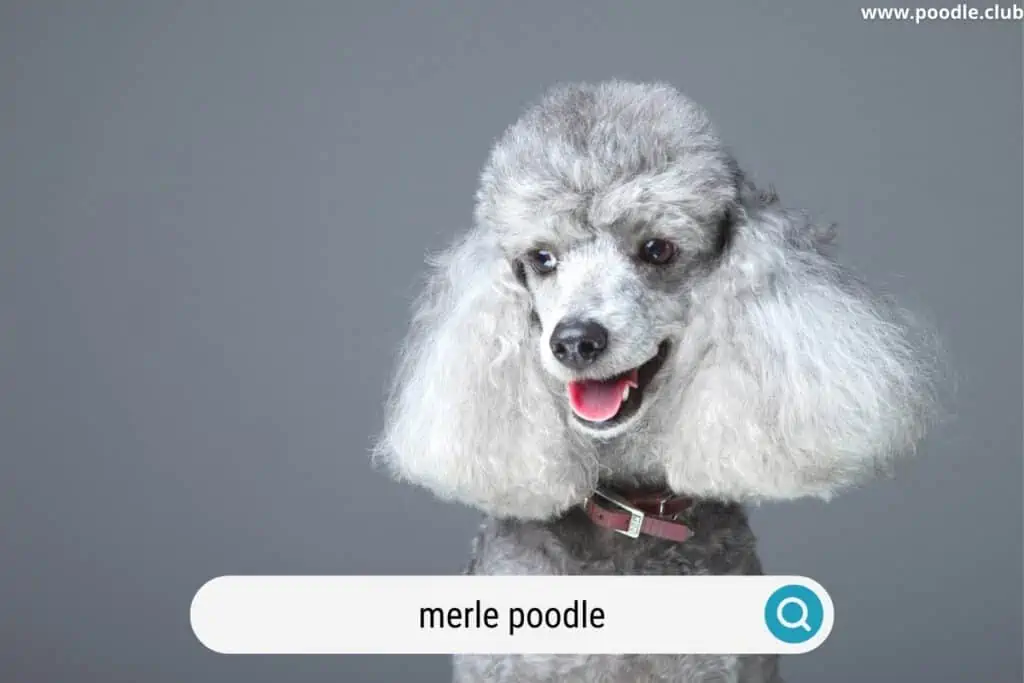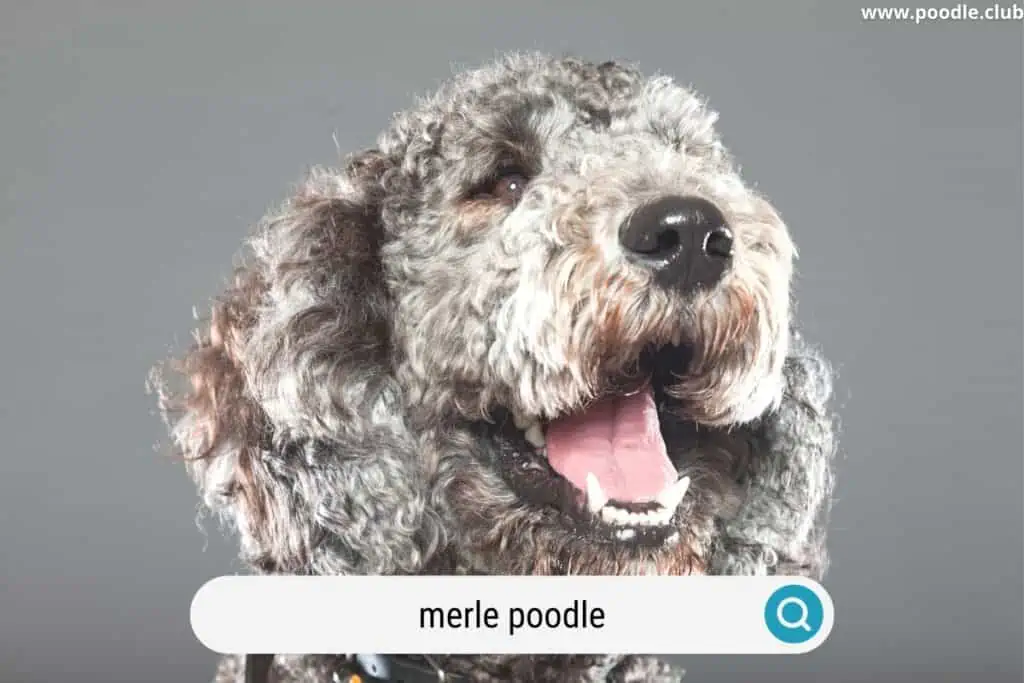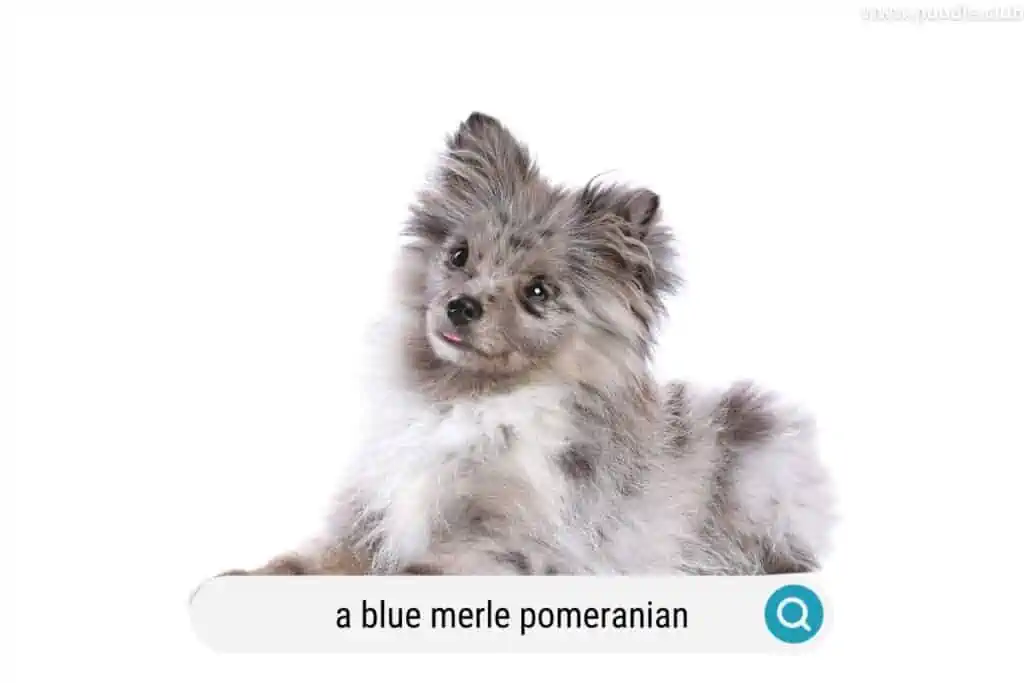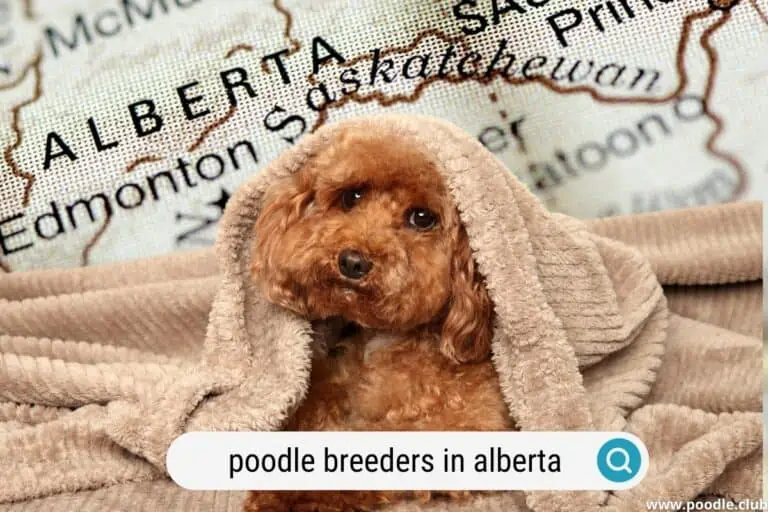Do Poodles Come in Merle [Risks]
Ever wonder if the intelligent and curly-coated Poodle comes in the striking merle pattern? This intriguing mix of colors creates a stunning effect on a dog’s coat, but is it a feature found in Poodles?
The simple answer is – not typically. Merle, a gene causing patches of diluted color, is common in breeds like Collies and Australian Shepherds, but not usually in Poodles. The instances of merle Poodles you might encounter are likely the result of crossbreeding with merle-carrying breeds. However, this doesn’t mean Poodles lack variety! These adorable dogs come in numerous solid colors, from classic black and white to exotic apricot and red, each lending their own charm.
Now, let’s unravel the mystery behind coat colors and patterns in dogs and explore the wonderful world of Poodle coat variety. After all, even without the merle gene, Poodles are undoubtedly fashionable in their own right!

Merle Poodles Overview
Origin and Popularity
Merle poodles are a unique and eye-catching variation of the beloved poodle breed. Their distinct coat pattern, known as merle, is characterized by a mix of colors and a random, speckled appearance. Though not as common as solid-colored poodles, merle poodles have been gaining popularity among dog lovers due to their striking appearance.
The merle pattern can occur in any poodle size, including toy, miniature, and standard poodles. It’s important to note that the merle gene is also associated with some health concerns, particularly when two merle poodles are bred together. Responsible breeding practices are essential to maintain the health and well-being of these captivating canines.
Sizes of Merle Poodles
Merle poodles come in three main sizes, just like their solid-colored counterparts:
- Toy Merle Poodle: The smallest of the bunch, toy merle poodles stand at 10 inches or less and weigh between 4 to 6 pounds. These pint-sized pups are perfect for those who want a compact, easy-to-carry merle companion.
- Miniature Merle Poodle: A bit larger but still small-sized, miniature merle poodles stand between 10 to 15 inches and weigh between 10 to 15 pounds. With their manageable size and eye-catching appearance, they make excellent companions for many households.
- Standard Merle Poodle: The most substantial in size, standard merle poodles typically stand over 15 inches tall and can weigh between 45 to 70 pounds. Known for their intelligence and athleticism, these elegant dogs offer a combination of beauty and brains.

In summary, the striking appearance of merle poodles has been captivating hearts around the world. Regardless of size, toy, miniature or standard, these poodles bring a dose of pizazz to the breed while maintaining the same intelligence, charm, and athleticism that makes poodles such a beloved pet choice. Remember to breed responsibly to maintain the health and happiness of merle poodles for generations to come.
PuppySpot is a reputable dog marketplace where you can browse and find compatible puppies right from the comfort of your home. They have placed over 200,000 puppies into homes in the US!
Coat Patterns and Colors
Poodles come in a delightful array of colors and coat patterns, making them popular pets among dog enthusiasts. Let’s take a closer look at the various base colors and patterns that you might encounter when admiring a Poodle.
Base Colors and Merle Pattern
Poodles shine in a spectrum of base colors such as red, tan, black, brown, white, and cream. Some Poodles even sport the merle pattern! A blue merle pattern, for instance, occurs when the poodle exhibits a gray coat with black spots, while a red merle pattern features a lighter red or cream coat with darker red patches. This variety in base colors sets the stage for the mesmerizing coat patterns we see in our beloved Poodles.
Now you might be thinking, “Merle pattern? Is that like a fancy marble finish on a kitchen countertop?” Well, sort of! The merle gene causes random patches of color throughout the dog’s coat, making each merle Poodle truly one-of-a-kind. Just remember, the merle gene is not a fashion statement – it’s a genetic trait which may be associated with some health issues, like deafness, especially in dogs with more extensive white markings.

Parti, Phantom, and Brindle Patterns
But wait, there’s more! Poodles can also come in some fantastic patterns like parti, phantom, and brindle. Let’s dive into these patterns as if we were exploring a magical Poodle fashion show!
- Parti: Imagine a Poodle wearing a polka-dotted outfit. That pretty much sums up the parti pattern! A parti Poodle will have a white base coat with large irregular patches of another color. Simply put, these Poodles are ready for a fabulous tea party.
- Phantom: Picture a mysterious Poodle with the stealth of a phantom. Phantom Poodles showcase a base color with tan markings above the eyes, on the muzzle, cheeks, chest, legs, and under the tail. They might look like they’re dressed up for a masquerade, but these are their natural markings!
- Brindle: Ever seen a Poodle decked out in a striped suit? Well, that’s the brindle pattern for you! Here, a Poodle’s coat will have dark and light strands blended together, giving off a striped appearance like a canine zebra.
There you have it! From the elegant base colors to the dazzling patterns, Poodles truly come in a rich and diverse range of coat styles. Who needs a fashion designer when you’ve got Mother Nature? With Poodles, you can count on every one of them being dressed to impress.
Genetics and Breeding
Poodles are known for their curly coats and loyal personalities, but did you know they can also come in a unique merle pattern? In this section, we’ll dive into the genetics and breeding aspects of merle poodles. But first, let’s understand what the merle gene is all about.
Merle Gene and Dominance
The merle gene is responsible for the distinctive coat pattern seen in various dog breeds, including poodles. This pattern consists of patches of different colors, giving the coat a marbled or speckled appearance. Merle is an incomplete dominant gene, which means that a dog only needs to inherit one merle allele to express the pattern. However, the pattern’s intensity may vary depending on the dog’s genetic makeup.
When breeding merle poodles, breeders need to be cautious with their mating pairs. Two merle poodles can produce “double merles” or “cryptic merles.” Double merles, inheriting one merle allele from each parent, often exhibit more white in their coat and are more likely to face health issues. In contrast, cryptic merles carry a hidden merle allele, which may only be detectable through genetic testing.
Health Concerns in Breeding Merle Poodles
Now that we know mastering the art of breeding merle poodles is no walk in the “dog park”, let’s talk about the potential health concerns these pups may face. The most common issues linked to merle coat patterns are deafness and blindness.
A study revealed that merle dogs have a higher chance of deafness compared to their non-merle counterparts. This risk increases in double merle poodles. Blindness, on the other hand, is often associated with the incomplete pigmentation of the eyes, which is more prevalent in double merles.
As responsible breeders, it’s essential to prioritize health over appearance. This means obtaining genetic testing, avoiding risky breeding pairs, and adhering to the guidelines set forth by organizations like the Kennel Clubs.
In conclusion, while merle poodles may dazzle us with their unique coats, it’s important to remember the genetics behind their patterns and consider the potential health concerns. Breeding merle poodles responsibly is crucial for ensuring the well-being of these curly-haired companions. Happy romps in the dog park depend on it!
Health Issues in Merle Poodles
Merle Poodles are known for their unique and beautiful coat patterns. However, this striking appearance comes with some potential health problems specific to the merle coloration in Poodles. Let’s dive in and learn about some of the main health concerns associated with Merle Poodles.
Deafness
One of the primary health issues in Merle Poodles is deafness. Merle Poodles with a dilute coat color, particularly in blue merles, have a higher risk of hearing impairments. It’s important to be aware of this risk when adopting or purchasing a Merle Poodle, as it may impact their communication and overall quality of life.
Blindness and Double Merle Syndrome
Another common health concern in Merle Poodles is blindness. Merle Poodles have an increased risk of vision problems due to the unique genetic makeup associated with the merle coat. One specific issue is double merle syndrome, which occurs when a dog inherits two copies of the merle gene. This can lead to microphthalmia, a condition where the eyes are abnormally small or underdeveloped.

Epilepsy and Other Health Concerns
Some Merle Poodles may also be at risk for epilepsy, though this health concern is less common than deafness and blindness. It is important to be aware of your Merle Poodle’s medical history, and consult with your veterinarian if you notice any concerning symptoms, like seizures or unusual behavior.
In conclusion, while Merle Poodles are undeniably attractive, potential owners should be aware of the increased risks associated with their unique coat color. By understanding the potential health issues, you can better care for your Merle Poodle and provide them with a happy, healthy life.
Poodles as Pets
Poodles are a popular breed for many families, with their intelligence, hypoallergenic coat, and various sizes fitting the needs of different households. They may not come in merle like their Australian Shepherd counterparts, but they do have unique features that make them a great choice for pet owners.
Temperament and Exercise Requirements
Poodles are known for their affectionate and playful nature, making them great companions for individuals and families alike. Don’t let the elegant appearance fool you; these dogs can have a goofy and fun side to them. They are also highly intelligent, which means they need mental stimulation as well as physical exercise.
Daily walks, playtime, and training sessions are essential for a happy and healthy poodle. Incorporating various activities like fetch, agility courses, or even swimming can keep your pup entertained and satisfied. Be prepared to spend quality time with your poodle, as they thrive on attention and can become unhappy if left alone for long periods.
Grooming and Maintenance
Poodles have curly, hypoallergenic fur that can come in various shades, including apricot, black, and white. While their unique coat means less shedding and fewer allergies for pet owners, this breed does require regular grooming.
Brush your poodle’s fur regularly to prevent matting and tangles, and invest in professional grooming services every 4-6 weeks to keep their coat clean and shaped. Additionally, Poodles need their ears checked and cleaned regularly to prevent infections, and their nails should be trimmed every few weeks.
It’s also crucial to buy your poodle from a reputable breeder to ensure that they’re a purebred poodle and not mixed with breeds that carry the merle gene. A well-bred poodle will have a strong temperament, good health, and a manageable coat that doesn’t include the merle pattern.
In conclusion, poodles make fantastic pets for those willing to invest time in their exercise and grooming needs. They may not have the merle coat that some dog enthusiasts adore, but they more than make up for it with their loving, intelligent, and adaptable personalities.
Controversy Surrounding Merle Poodles
Breed Standard and AKC Recognition
The merle coloring in poodles has been a topic of contention among dog enthusiasts. Traditionally, poodles come in a variety of solid colors, but the merle pattern is more commonly associated with breeds like Australian Shepherds and Cardigan Welsh Corgis. Some believe that merle poodles have been introduced through crossbreeding with other merle breeds, which raises questions about the legitimacy of this color in the poodle breed standard.
The American Kennel Club (AKC) acknowledges several different poodle colors but does not recognize the merle pattern. This exclusion can affect a merle poodle’s eligibility for competitions or even purebred registration. With merle poodles being on the controversial side, some dog owners may face skepticism when introducing their multi-colored poodle at the dog park, making it feel like they have to give a DNA test on the spot.
Ethical Concerns in Breeding Merle Poodles
Apart from AKC recognition, there are genuine health-related concerns associated with breeding merle poodles. The merle gene can bring an increased risk of deafness, epilepsy, and vision issues, which poses a potential hazard to the pups’ well-being. In breeds like Shetland Sheepdogs, heterozygous merles have a higher risk of deafness.
Moreover, the so-called “hidden merle” or “cryptic merle” phenomenon may occur when breeding merle poodles with other poodle colors. This can result in pups with unexpected merle genes, which can further complicate breeding plans. It’s like trying to match outfits only to discover hidden dashes of color on them, making fashion faux pas while dog breeding.
In conclusion, the debate around merle poodles is a mix of pedigree concerns and health issues. While these poodles may have a unique appearance garnering attention from fellow dog lovers, it’s essential to consider the bigger picture. Being a responsible and ethical dog owner means putting the well-being of our intelligent, sensitive poodle friends at the heart of our actions. After all, you can’t put a price on good health and happiness.







